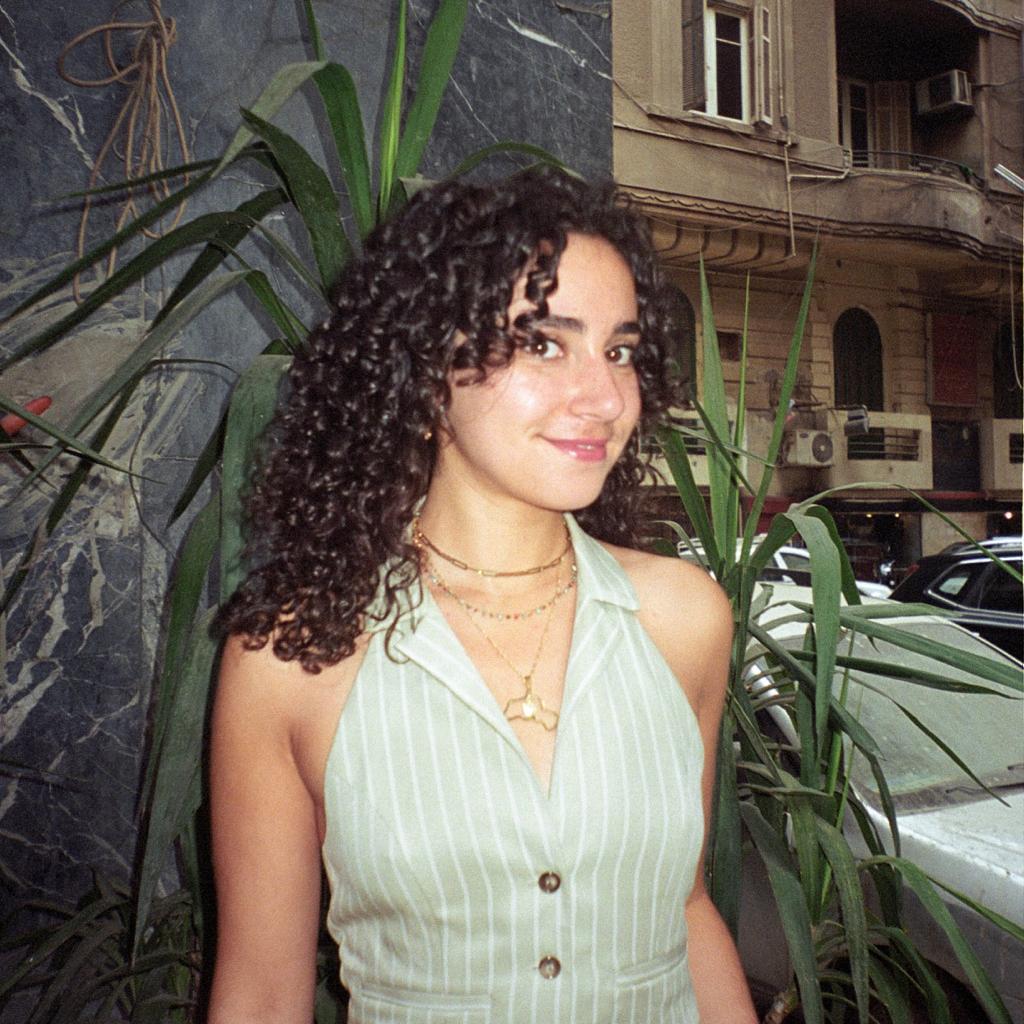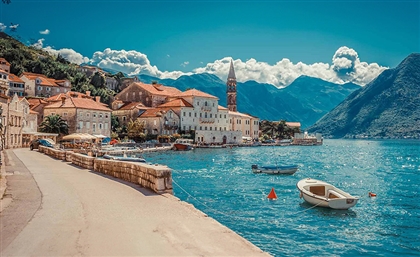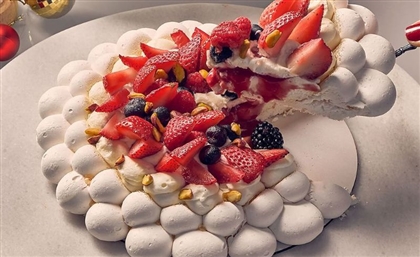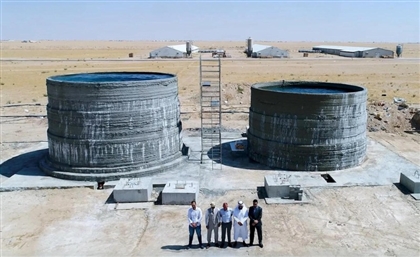The Road To Our Roots: Retracing Ancestry on a Trip through Kurdistan
Bookended by the cities of Erbil and Suleimaniyah, staff writer Lana Mawlood offers a personal glimpse of the scenic route through the Soran province in Kurdistan, northern Iraq.
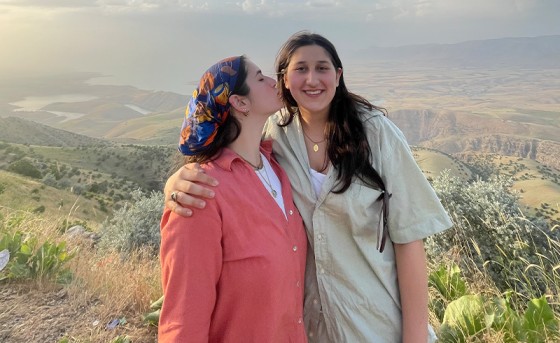
Growing up, I’d heard a lot of stories about Kurdistan. Anecdotes of its natural beauty and songs of historic struggle were compiled into volumes of memory I’d inherited from my grandmother. Plans to visit were many times made, but many times dissolved by personal circumstance – and then a pandemic – yet ancestral curiosity often endures, and, in my case, it led me to take the long road back to my roots.
Logistics are far less poetic. With a deluge of messages sent on the group chat and a course of sitcom-style family calls concluded, our mission of organising the clan was complete. Catching flights varyingly from the UK, Germany and Egypt, the family finally assembled at Erbil, capital of the Kurdish Region of Iraq, the area which we call in Kurdish, ‘Bashur.
Landing from Cairo into Erbil International Airport, I ran into a minor 5am identity crisis when asked, at the visa desk, for proof of my Kurdish identity in order to avoid the $70 entry fee. Bedraggled by a night of air travel (and also a little sleep-deprived from a music festival that weekend), I didn’t have the required documents, or brain cells, for that matter, to prove that I was indeed Kurdish – cue the Edward Saidian cliché of the diasporic child who doesn’t know where their place is in the world.
Carving out a dynamic (read: manic, coffee-fuelled) path to reap as much of the land’s goodness as possible in a week, our family of self-fashioning intrepid travellers set off in two jeeps on a trip bookended by the region’s two major cities of Erbil and Suleimaniyah.
I want to mention here that the expedition recounted is by no means a comprehensive guide to Kurdistan. Duhok, Akre and the Halgord Mountain were among some of the beautiful places that we did not have time to visit. What I hope to offer here instead is a personal glimpse of the scenic route through the Soran and Erbil provinces, and my recommendations for those seeking an immersive encounter with Kurdish culture.
Shaqlawa and Gali Ali Beg
The mountains of Kurdistan have served time and again as a refuge for its people, an enduring symbol of resilience and unity – not to mention a crowning feat of natural beauty – and so of course, this is where we headed first.
Leaving behind the oil-city-esque cityscape of Erbil, we kick-started day one of our road trip with a venture through Shaqlawa, a rural haven of iron-reddened mountains and thistle meadows. With my uncle on the aux, the car became a listening session for funk-infused nostalgia by Nasser Razzazi and Medya Hassan on loop. Stopping by a cluster of picnic tables by a stream along the way, my auntie told us about how they’d come here often in the 70s and 80s to celebrate Newroz, the Kurdish New Year marking the spring equinox, and dance together in what’s known as the shaee.
-d7121a4e-4bd2-4cef-96e9-7cb81d66edd2.jpg) The highest waterfall in Kurdistan and Iraq, Gali Ali Beg flows from 12 metres high and has become one of the country’s most frequently visited natural sites. Bring flip flops if you visit: we waded our way through (shallow) waters to reach the cascades, along a walkway that’s canopied by hanging umbrellas. It’s a kitsch look that reflects the regrettable commercialisation of a space which, as my auntie related to me, was once untouched. The rock formations themselves date back 25 million years to the Miocene Era, a convergence of the Arabic and Iranian plates on the Zagros Mountain curve. Today, tourists hire small boats at the plunge pool, and replenish energy levels with fresh fruit, honey and coffee from the cluster of stalls below.
The highest waterfall in Kurdistan and Iraq, Gali Ali Beg flows from 12 metres high and has become one of the country’s most frequently visited natural sites. Bring flip flops if you visit: we waded our way through (shallow) waters to reach the cascades, along a walkway that’s canopied by hanging umbrellas. It’s a kitsch look that reflects the regrettable commercialisation of a space which, as my auntie related to me, was once untouched. The rock formations themselves date back 25 million years to the Miocene Era, a convergence of the Arabic and Iranian plates on the Zagros Mountain curve. Today, tourists hire small boats at the plunge pool, and replenish energy levels with fresh fruit, honey and coffee from the cluster of stalls below.
Rawandiz
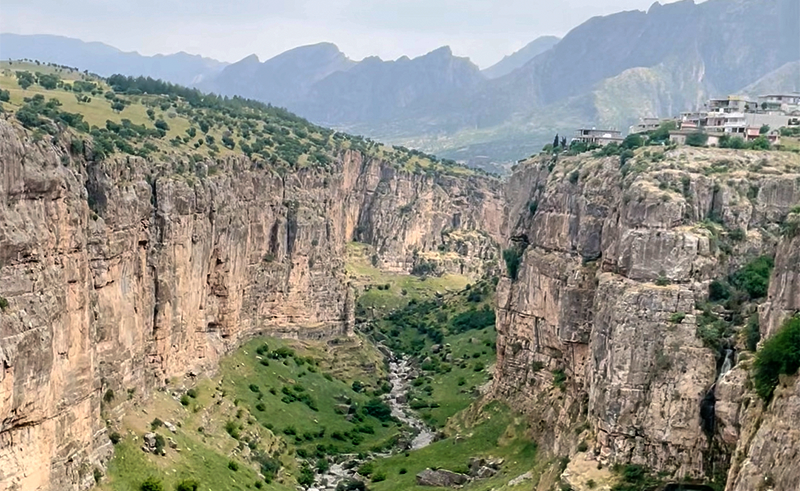 Perhaps my personal highlight of the road trip was the Rawandiz Canyon, a humbling expanse between rock walls that was still draped in springtime greenery when we visited. Stopping off at the roadside, a local stall-keeper brought us chairs and brewed fresh coffee from an outdoor stove.
Perhaps my personal highlight of the road trip was the Rawandiz Canyon, a humbling expanse between rock walls that was still draped in springtime greenery when we visited. Stopping off at the roadside, a local stall-keeper brought us chairs and brewed fresh coffee from an outdoor stove.
Qahwe Qaswan is an ancient Kurdish drink made from the roasted and ground Terebinth fruit, rich in antioxidants, caffeine-free and a natural aid for digestion. The country’s traditional pick-me-up, Qahwe Qaswan soon became my order at every cafe and pit stop and I began to informally chart the varying levels of milk and sweetness in each blend. The tentative verdict: in the cities we visited, Qahwe Qaswan tended to be a little weaker and powder-based, but out in Rawandiz we enjoyed a raw and bold cup.
-acc272a9-cb72-4d7d-8b5b-bb3d979d39e7.png) At the time of the Neo Assyrian Empire from 10th to 7th centuries BC, Rawadiz lay on the trading route to Nineveh, Mesopotamia’s flourishing capital. Today, the Soran-Khalifan road, also known as Hamilton road after its lead engineer AM Hamilton, stretches 185 km across the Zagros mountains to the town of Haji Omeran on the Iran-Iran border. It’s considered one of the most stunning routes in Western Asia, and I see why. Whilst propped on the cliff face, it started to rain, and we fell silent, watching the rainpath protract and wet the shrubs and contours of the land below.
At the time of the Neo Assyrian Empire from 10th to 7th centuries BC, Rawadiz lay on the trading route to Nineveh, Mesopotamia’s flourishing capital. Today, the Soran-Khalifan road, also known as Hamilton road after its lead engineer AM Hamilton, stretches 185 km across the Zagros mountains to the town of Haji Omeran on the Iran-Iran border. It’s considered one of the most stunning routes in Western Asia, and I see why. Whilst propped on the cliff face, it started to rain, and we fell silent, watching the rainpath protract and wet the shrubs and contours of the land below.
Bekhal
In the cleft between two plateaus is the small town of Bekhal, a charming locale where we stocked up on fresh pomegranate juice, dried figs and kamareddine, sheets of apricot paste. The land’s coronary artery and decorative jewel here is the Bekhal Waterfall, majestic and foaming at the edge of the town centre.
On the ascent to the next mountaintop, we passed picnic tables spherically shaped like bubbles, holding cinematic views of Bekhal. Known as ‘sayran’ in Kurdish, the humble picnic is one of the most common ways for friends and family to meet and catch up, a feature that visibly caught my attention. A shrug to consumerism and the Starbucks hegemony elsewhere in the world, I noticed families here gathering instead in the country’s parks, valleys, hilltops, fields and lakes. It’s something I know has been brought over to the UK, where I grew up. The aunties would bring pots and pans of rice and stews – practically the whole kitchen – to the (much less appealing) park spaces in Wood Green, London, in an attempt to recreate what happens back home.
Korek Mountain and Shingelbana
We spent the night in Shingelbana, a mountain-top resort, with each of its rose-adorned villas overlooking the Rawandiz Valley. Aside from its twee decor, the atmosphere at Shingelbana makes for an idyllic experience: we passed friendship groups and a bride and groom taking sunset strolls, families playing ball games in the garden areas. We tried out one of their four rides: a suspended railway that shuttles across 1.5km of track that veers off of the rock face, giving you a look into Bekhal and Gali Ali Beg Waterfall. Not one for the faint-hearted.
-1d134a5e-9278-4f69-82c1-ad404abb03d3.jpg) Breakfast the next morning fed the heart: a sprawl of warm flatbreads, tahini, sweet molasses, various white cheeses, dates, fig jam, boiled eggs and honeycomb, plated delicately in small earthenware cups. Evergreen forestry rises from the terrain below to kiss the restaurant balcony, and the resting slopes of Korek Mountain in the distance whet the appetite for our next mountain-bound journey..
Breakfast the next morning fed the heart: a sprawl of warm flatbreads, tahini, sweet molasses, various white cheeses, dates, fig jam, boiled eggs and honeycomb, plated delicately in small earthenware cups. Evergreen forestry rises from the terrain below to kiss the restaurant balcony, and the resting slopes of Korek Mountain in the distance whet the appetite for our next mountain-bound journey..
At a lofty 2076 metres above sea level, the peak of Korek Mountain is reachable by a quiet ten minutes upward in the Doppelmayr Teleferic and provided us cooler environs from the valley’s heart. The cable car journey is dead quiet, the mind stills and rests on rock and shrub below. It’s a geological formation dating back 165 million years to the Jurassic era, and so being in Korek’s cradle bore a certain comfort, that of being enveloped in prehistory.
This said, tourist infrastructure is well-supported here, with Korek Mountain Resort (currently under construction) welcoming hikers – as well as skiers in winter.
Dukan and Qarangwe
Home to Iraq’s largest lake, the land around Dukan features gentler, grassy hills pin-pricked red with poppies. A man-made structure from the 1950s, the Dukan Dam was built for irrigation and water storage, and we were fortunate enough to be welcomed for a close-up view of the industrial giant.
-15553646-e696-4ac4-a31c-a05ea2d15ef3.jpg) The surrounding land is archaeologically rich, with temples and clay tablets excavated at the sites of Tell Bazmusian, ed-Dem, Kamarian, Qarashina and Tell Shemshara. In a town hub perched on the Lesser Zab River nearby, we stopped for samak masgouf: a traditional Iraqi dish of grilled carp and spiced tomato sauce.
The surrounding land is archaeologically rich, with temples and clay tablets excavated at the sites of Tell Bazmusian, ed-Dem, Kamarian, Qarashina and Tell Shemshara. In a town hub perched on the Lesser Zab River nearby, we stopped for samak masgouf: a traditional Iraqi dish of grilled carp and spiced tomato sauce.
Now headed southbound to Sulaymaniyah along the Dukan-Bargalu Road, we wove a path through the village of Qaranqwe, abundant in vine fields and enormous 400-year-old oak trees. At Sargaloo, our relative took us fossil-hunting, and pointed out fig tree roots in the rock cave that hardened into stone with age.
Suleimaniyah
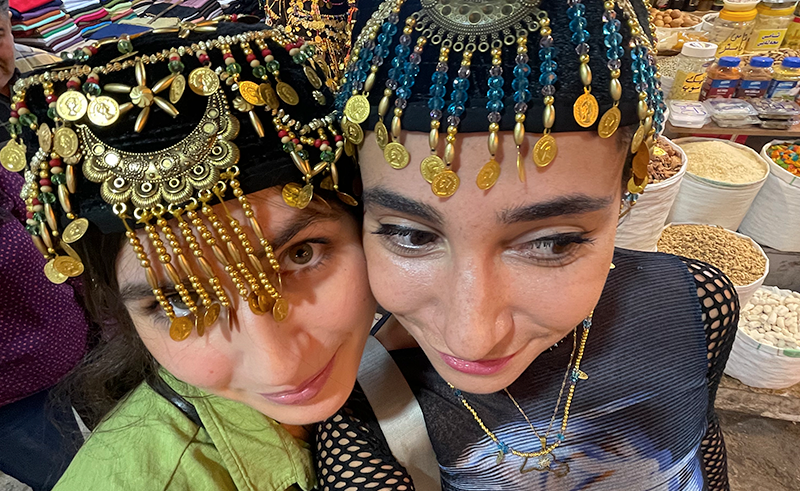 The last stop on our itinerary, Suleimaniyah is known as a vibrant hub of arts and culture, and, at least from what I personally observed, seemed a little less socially conservative than Erbil. At the bazaar, we browsed embroidered fabrics, amulets of the turquoise evil eye and henna for treating and dyeing hair. I bought myself a pshten, gold jewellery that is worn around the waist of the traditional Kurdish dress. At an old record store, I grew my vintage tape collection with cassettes from the popular singers Bakhtiyar Salih and Merziyeh Feriqi. In the evening, we took a stroll through Azadi Park for some respite from the bustle of the marketplace.
The last stop on our itinerary, Suleimaniyah is known as a vibrant hub of arts and culture, and, at least from what I personally observed, seemed a little less socially conservative than Erbil. At the bazaar, we browsed embroidered fabrics, amulets of the turquoise evil eye and henna for treating and dyeing hair. I bought myself a pshten, gold jewellery that is worn around the waist of the traditional Kurdish dress. At an old record store, I grew my vintage tape collection with cassettes from the popular singers Bakhtiyar Salih and Merziyeh Feriqi. In the evening, we took a stroll through Azadi Park for some respite from the bustle of the marketplace.
Often being invited by relatives to eat, we didn’t get a chance to explore restaurant culture in Suleimaniyah, but Mandela came frequently recommended for good cocktails, and Jan’s Breakfast is a comfy spot where artists and creatives often gather. For a taste of traditional Kurdish dishes, order nok, warming chickpea stew, or yaprakh, vine leaves and vegetables stuffed with dill rice and (sometimes) meat.
A sobering afternoon was spent in Amna Suraka, the prison where Kurdish ‘dissidents’ of the Baa’thist regime were kept and tortured. The site nowadays is a museum that tells the story of the Anfal Campaign of 1991 under Saddam Hussein, where up to 182,000 Kurds were killed with chemical gas in an act of ethnic cleansing. The site features a corridor whose walls are lined with mirror shards, each piece representing a family that was killed. Yet today, this space also serves as a cultural arts space, where exhibitions and talks are hosted. As much as the afternoon was a harrowing immersion of life under the Baa’thist regime, it was a lesson of Kurdish resilience.
A sobering afternoon was spent in Amna Suraka, the prison where Kurdish ‘dissidents’ of the Baa’thist regime were kept and tortured. The site nowadays is a museum that tells the story of the Anfal Campaign of 1991 under Saddam Hussein, where up to 182,000 Kurds were killed with chemical gas in an act of ethnic cleansing. The site features a corridor whose walls are lined with mirror shards, each piece representing a family that was killed. Yet today, this space also serves as a cultural arts space, where exhibitions and talks are hosted. As much as the afternoon was a harrowing immersion of life under the Baa’thist regime, it was a lesson of Kurdish resilience.
On our last night, after spending the day between museums and the bazaar, we drove to the top of Azmar Mountain, a social hotspot where groups both old and young will come for unfettered beer-drinking and gossiping under moonlight, with a shared bag of sunflower seeds. Surveying the jewelled cityscape by night, I could see the colours of the Kurdish flag illuminated in the distance on the opposing slope: red for the struggle for freedom and dignity, white for peace and equality, green for Kurdistan’s natural beauty, and the yellow sun for the light of its people.
- Previous Article سندباد الورد أضحي سلطاناً: مراجعة لألبوم شب جديد والناظر 'سلطان'
- Next Article Egyptian Embassies Around the World
Trending This Week
-
May 13, 2024



